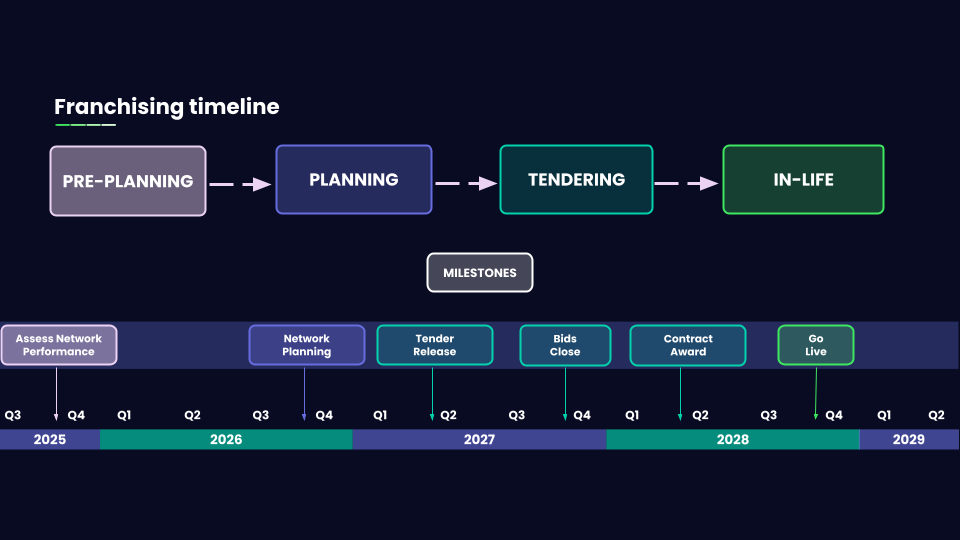Franchising offers local transport authorities the opportunity to be more involved in the delivery of reliable, efficient, and passenger-focused services. But to make it work, it’s essential to start with a clear understanding of what’s happening in your current network.
That’s why the pre-planning stage is so critical. Before a single tender is issued or timetable redesigned, you need to know what’s working, what isn’t, and what your data can tell you. Here’s how a data-led approach during pre-planning lays the foundation for franchising success.
How does taking a data-led approach fit within your franchising timeline?
Every authority works to its own in-life launch date, so it’s important to map your franchising timeline by starting with that target and working backwards. This helps define the key stages and milestones along the way. The timeline below outlines an example network aiming to launch in late 2028, and highlights when pre-planning would need to start to stay on track.

Let’s dive into the tasks that need to be completed during pre-planning for franchising to ensure you have everything you need in place before you start planning for your in-life network
Pre-planning for franchising your bus network
Assessing existing network performance
Before a new franchised network can be designed, you need to understand how the current one is performing. Your first step is to identify the performance data available, including assessing how accurate and reliable it is to avoid making bad decisions with bad data.
To make informed decisions at the earliest stage of franchising, local authorities need access to consistent and accurate performance data. This includes schedule data, AVL (Automatic Vehicle Location) feeds, and, where available, ticketing and demand insights.
Combining these sources gives authorities a clear picture of what’s happening on the ground. By identifying gaps, inefficiencies, and passenger pain points early, data helps set realistic performance expectations and informs better planning decisions right from the start. These insights can then be used to inform the design of the future franchised network.
What happens if you don’t use performance data in pre-planning?
- You risk carrying over existing issues into the franchised network: Without performance data, authorities may unintentionally replicate poor scheduling, inefficient layover times, low-performing routes, or service gaps that already exist. A franchised network designed on assumptions rather than historical data is likely to suffer from the same problems, just under a different operating model.
- You're unable to set realistic performance targets: Without baseline targets built from historical performance data, authorities may set KPIs for punctuality, reliability, and resource efficiency that are either unachievable (causing friction with operators) or too lenient (limiting service improvement).
- Resource allocation becomes guesswork: If you don't know where the network is over-resourced (excess layover, low-demand services) or under-resourced (crowding, missed connections), you can't optimise network performance or control costs effectively.
- You miss opportunities to deliver quick wins: Historical data can highlight performance bottlenecks or punctuality blackspots that could be fixed early, before they’re locked into long-term franchise agreements. Identifying the 10 worst-performing stops or most delayed corridors can inform targeted infrastructure improvements or timetable tweaks that make a tangible difference early on.
- Passenger experience doesn’t improve: Without analysing passenger journey trends (O/D flows, crowding, variability), the network risks being restructured without delivering better outcomes. Passengers may see little benefit from franchising, especially if journey time consistency, connections, and reliability don’t improve.
Get your franchised network planning off to a strong start
If you're in the early stages of franchising, now is the time to get your data in order. Completing a bus network data audit will help you identify what data you have, where the gaps are, and whether it’s ready to support your franchising journey.






